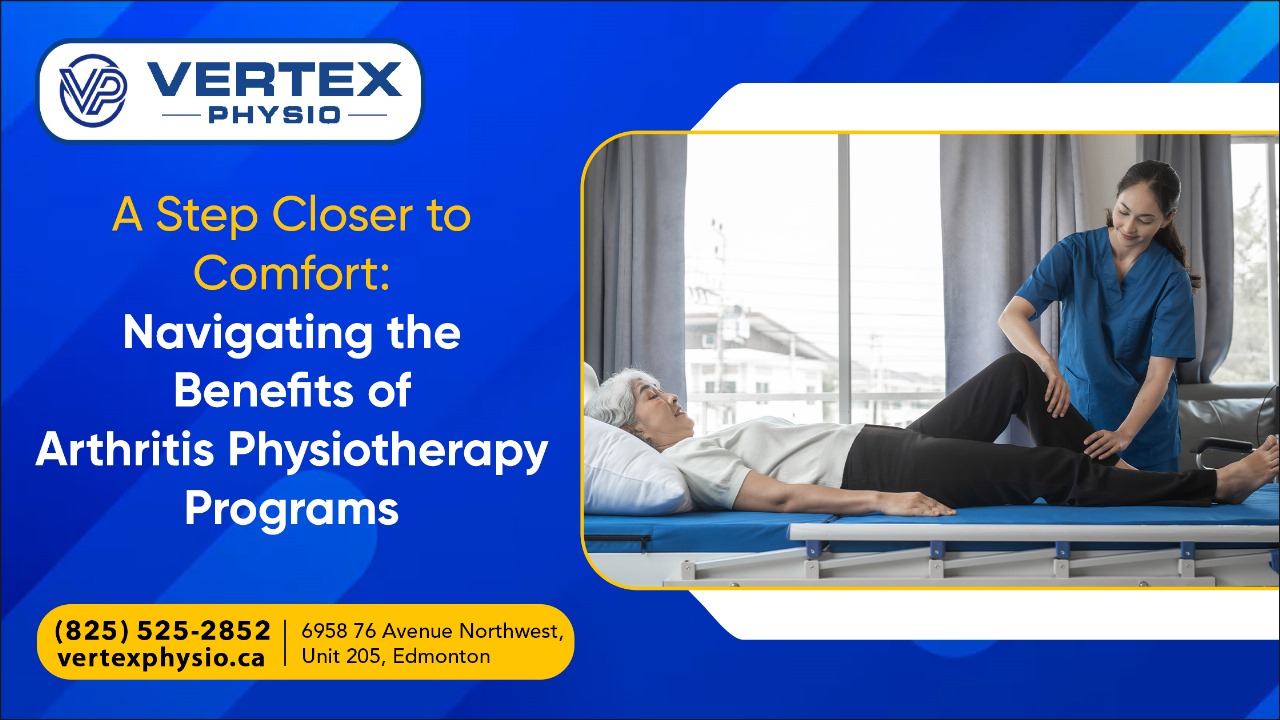Living with arthritis can be challenging, often marked by joint pain, stiffness, and decreased mobility. However, arthritis physiotherapy programs offer a beacon of hope, providing effective ways to manage symptoms and improve quality of life. In Edmonton, clinics like Vertex Physiotherapy specialize in such programs, tailoring them to meet the unique needs of each individual with arthritis. This guide explores the various benefits of arthritis physiotherapy in Edmonton and how it helps individuals step closer to comfort and improved mobility.
Understanding Arthritis and Its Impact
Arthritis, characterized by inflammation in the joints, can lead to significant discomfort and restrict daily activities. Symptoms could differ from mild to severe and progress over time. The key to managing arthritis lies in understanding its nature and implementing effective strategies to control its symptoms, which is where physiotherapy plays a crucial role.
Core Elements of Arthritis Physiotherapy Programs
Pain Management
One of the primary goals of physiotherapy in arthritis management is pain relief. Techniques like electrical stimulation, ultrasound, and manual therapy, such as massage and joint mobilizations, are used to reduce joint pain and inflammation. Physiotherapists also teach pain management strategies that patients can use at home.
Improving Joint Mobility
Regular joint mobilization exercises provided by physiotherapists can help to loosen stiff joints and improve the range of motion. Hydrotherapy, which involves performing exercises in water, is particularly effective for gentle joint mobilization. Stretching routines are also customized to each patient’s needs to enhance joint flexibility.
Increasing Muscle Strength
Targeted strength training exercises are crucial for supporting weakened joints. Physiotherapists focus on exercises that strengthen the muscles surrounding the affected joints without exacerbating pain. This approach not only supports the joints but also helps in reducing overall fatigue.
Enhancing Physical Function and Activity Levels
Physiotherapy aims to boost patients’ endurance and functional capacity through tailored exercise programs. These programs often include aerobic exercises and functional training to improve the ability to perform daily activities. Patients are also trained in safe and effective ways to engage in their hobbies and leisure activities.
Education on Joint Protection
Physiotherapists educate patients on the use of assistive devices like braces or orthotics, which can help in reducing joint strain. Techniques for efficient movement and lifting are also taught to protect the joints during everyday activities. Additionally, patients learn how to modify activities to prevent arthritis flare-ups.
Weight Management Guidance
Nutrition advice and low-impact aerobic exercises are part of the physiotherapy program to help patients achieve and maintain a healthy weight. This guidance is crucial as it helps reduce the extra burden on weight-bearing joints like hips and knees. Weight management also contributes to improved mobility and reduced pain.
Balance Training
Physiotherapists employ specific exercises that challenge and improve balance, including standing on one leg or walking heel-to-toe. These exercises are often combined with strength and flexibility training to enhance overall stability. Balance training is especially important for elderly patients to prevent falls.
Posture Correction
Corrective exercises and ergonomic advice are provided to improve posture, which can significantly impact joint and muscle strain. Therapists may use mirrors or video feedback to help patients understand and correct their posture. Good posture helps distribute weight evenly, reducing excess stress on certain joints.
Aerobic Conditioning
Cardiovascular exercises are tailored to each patient’s abilities and limitations. Activities like cycling, swimming, or using an elliptical machine provide aerobic benefits without putting excessive strain on the joints. Consistent aerobic exercise can also help in improving sleep and mood, which are often affected by chronic pain.
Flexibility and Stretching Exercises
Regular stretching exercises are crucial for maintaining and improving flexibility, which can decrease as a result of arthritis. Yoga and Pilates can be beneficial in maintaining joint flexibility and muscle length. These exercises also contribute to a better range of motion and reduced stiffness in the joints.
Living with Arthritis: Long-Term Management and Support
- Home Exercise Programs: Empowering patients to manage their arthritis independently is a key goal of physiotherapy. Therapists provide personalized home exercise programs that patients can perform to maintain their joint health. These programs typically include a combination of stretching, strengthening, and aerobic exercises, along with instructions on how to perform them safely and effectively at home.
- Lifestyle Modification Guidance: Advice on weight management, diet, and other lifestyle factors that can influence arthritis symptoms.
Embracing a Life of Enhanced Mobility and Comfort
Arthritis doesn’t have to mean a life of pain and limited mobility. With the right physiotherapy program, like those offered at Vertex Physiotherapy in Edmonton, individuals with arthritis can experience significant relief from symptoms and enjoy a higher quality of life.
If you or a loved one is battling arthritis, consider exploring the benefits of a specialized arthritis physiotherapy program. Reach out to a clinic like Vertex Physiotherapy in Edmonton and take that crucial step towards a more comfortable and active life.

